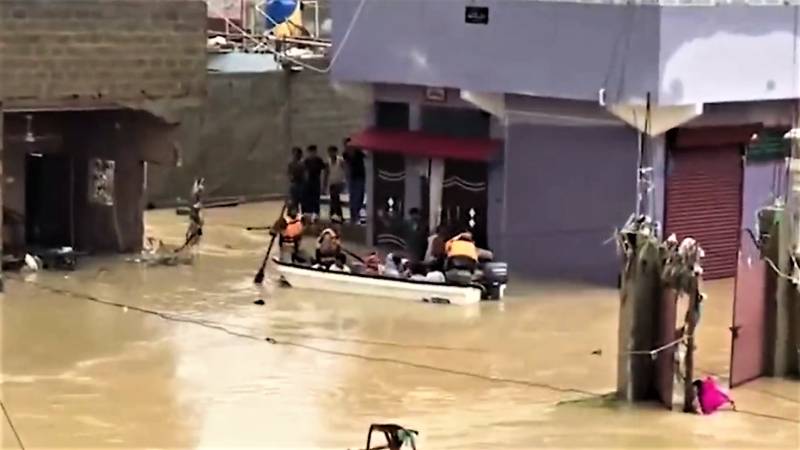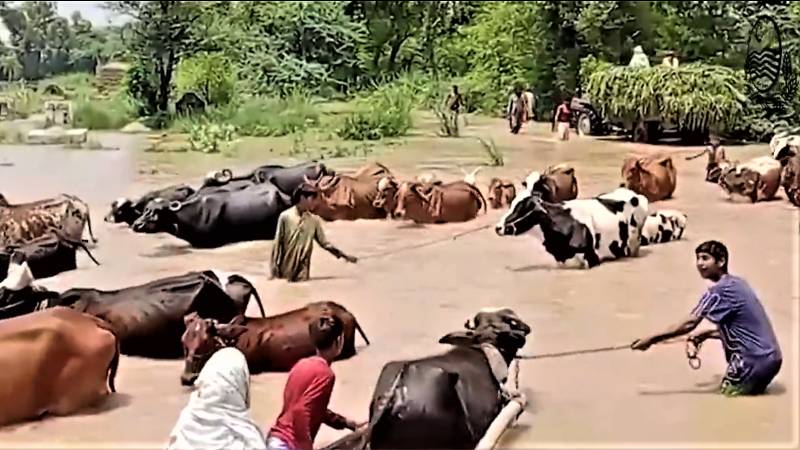
Rescue services in eastern Punjab have evacuated some 100,000 people affected by a flood in the 'dry' River Sutlej after India released rainwaters downstream.
Several hundred villages and thousands of acres of cropland in the heart of Punjab were inundated after the River Sutlej burst its banks on Sunday.
Sutlej enters Pakistan in the eastern district of Kasur in Punjab, at the Kasur-Ganda Singh Border. It then meanders along the border between Pakistan and India until Okara and then terminates at the Sulemanki headworks.
"We have rescued 100,000 people and transferred them to safer places," said Farooq Ahmad, a spokesperson for the Punjab emergency services.
In a situation report issued on Tuesday, the National Disaster Management Authority stated that the river had swallowed GS Wala due to high flood - albeit on a decreasing trend. The reading at GS Wala was 129,885 cusecs.
حساس علاقوں کیجانب ٹریفک کی منظم نگرانی کی جائے. ہنگامی صورتحال سے نمٹنے کیلئے مشینری تیار رکھیں۔ نشیبی علاقوں میں رہائش پذیر لوگ کہ نقل مکانی کیلئے انتظامات کیے جائیں۔ pic.twitter.com/mDvLX9MUYC
— NDMA PAKISTAN (@ndmapk) August 22, 2023
Moreover, the river remained on "very high flood" at Sulemanki with the water at 191,053 cusecs, while the districts of Kasur, Okara, Bahawalnagar, Pakpattan, Vehari, Bahawalpur and Lodhran remain at risk.
The NDMA further warned that heavy rains could also create medium to high floods in the northern river of Jhelum at Mangla.
It advised the Punjab Disaster Management Authority (PDMA) to evacuate all at-risk regions, especially those living downstream from GS Wala, Sulemanki and Islam on the River Sutlej.
The PDMA, in a report, has warned that additional monsoon rains could exacerbate the flooding in the coming days.
دریائے ستلج میں سلیمانکی کے مقام پر انتہائی اونچے درجے کا سیلاب ہیڈ اسلام میں بھی پانی کی سطح میں مسلسل اضافہ ہو رہا ہے ۔
— PDMA Punjab Official (@PdmapunjabO) August 22, 2023
ڈی جی پی ڈی ایم عمران قریشی کی انتظامیہ کوالرٹ رہنے کی ہدایت #FloodAlert #PDMA #StayAlertStaySafe pic.twitter.com/GnDRkaIOWq
Punjab Caretaker Chief Minister Mohsin Naqvi has said that monsoon rains had prompted authorities in India to release excess reservoir waters into the River Sutlej, causing flooding downstream on the Pakistani side of the border.
Over 175 people have died in rain-related incidents in Pakistan since the monsoon season began in late June. Emergency services said that most of the fatalities were caused by electrocution and buildings collapsing.
The flooding has submerged roads, impacting evacuation and provision of supplies.
Rescue services are now using boats to commute in areas that the flood has hit the hardest.

Pakistan is still recovering from the devastating floods that inundated nearly one-third of the country in 2022, affecting more than 33 million people.
Scientists have said climate change is making seasonal rains heavier and more unpredictable.
According to officials, Pakistan, which has the world's fifth-largest population, is responsible for less than one percent of global greenhouse gas emissions, but is highly vulnerable to extreme weather exacerbated by global warming.

